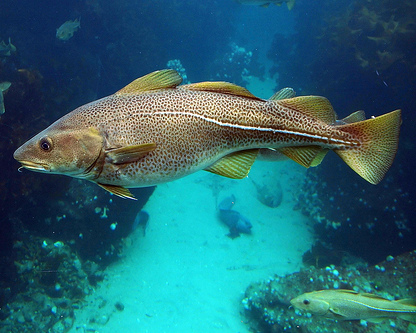9/3 Adaptions

https://www.google.com/url?sa=i&url=https%3A%2F%2Fconservefish.org%2F2019%2F08%2F22%2Fstatus-of-stocks-report-reminds-us-of-the-importance-of-science-based-fisheries-management%2Fatlantic-cod-noaa%2F&psig=AOvVaw06Cq1AYU6n4KS5d6l7WP2Z&ust=1599691538290000&source=images&cd=vfe&ved=0CA0QjhxqFwoTCNiUrsHR2usCFQAAAAAdAAAAABAD
One of the examples of microevolution that we discussed was that of Atlantic Cod. The example was specific to a fishery that the cod were fished from. Overtime both the average body length and the 50% maturity rate declined. This microevolution occurred in large part due to the overfishing of the fishery. Fishermen targeted the larger fish and inadvertently the fish that matured faster as well (they got bigger faster, so they made up more of the large fish.) This left a larger population of smaller fish and fish that did not mature quickly. These smaller fish or slowly maturing fish reproduced with each other because there were not many large or quickly maturing fish left in the fishery. As a result, the offspring were small fish or slow maturing as well. This continued for subsequent generations and more large fish were lost with each generation. The removal of the large or quickly maturing fish from the fishery changed the allelic frequency in the population. The alleles that allowed for smaller or slowly maturing fish increased in frequency and as a result the corresponding phenotypes increased as well. All of this together led to the overall decline in average body length and 50% maturity rate in the population.

https://www.google.com/url?sa=i&url=http%3A%2F%2Fwww.fao.org%2Ffishery%2Fculturedspecies%2FGadus_morhua%2Fen&psig=AOvVaw0RyrWTsBVotREeOpuEvPNU&ust=1599691994894000&source=images&cd=vfe&ved=0CA0QjhxqFwoTCJiE3pjT2usCFQAAAAAdAAAAABAD
To break it down by steps:
1) Larger and quickly maturing fish are taken from the fishery
2) Smaller and slowly maturing fish are left in the fishery
3) Smaller and slowly maturing fish reproduce with each other
4) Smaller and slowly maturing offspring are born
5) Process is repeated throughout generations
6) The population is smaller and matures slower than what it once did
Comments
Post a Comment